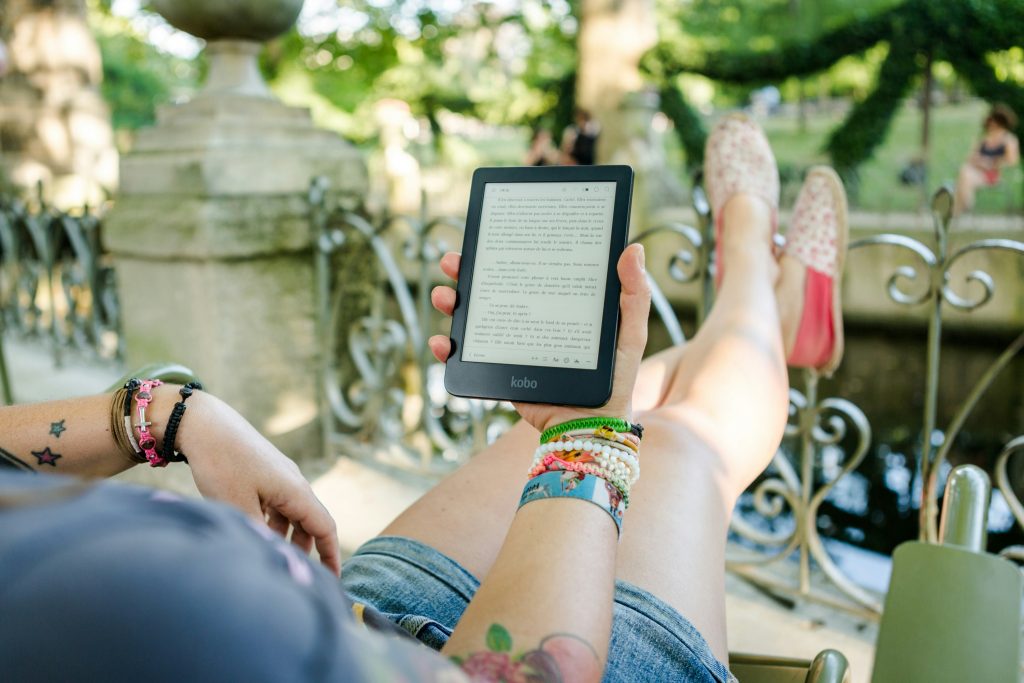
Emily sat by the window of her favorite café, sipping on a steaming cup of coffee. The early morning sun peeked over the horizon, casting a soft glow on the table where her new novel lay open. She loved moments like this—quiet, peaceful, with the satisfying weight of a book in her hands. There was something timeless about it, she thought. As she turned the pages, she felt the roughness of the paper under her fingertips and inhaled the faint scent of ink and parchment.
Across the table sat her friend, Jack, engrossed in his e-reader. The sleek, compact device gleamed in the morning light as his fingers tapped lightly on the screen to turn the page. Jack hadn’t brought a single paperback in months, yet somehow he was always carrying around dozens of books with him. Emily glanced at him, a little intrigued, a little amused.
“Still on that thing?” she asked with a teasing smile.
Jack looked up, his eyes bright. “You’re missing out, Em. This thing can hold thousands of books, and I can highlight, search, and carry them all with me wherever I go. Plus, it’s way easier on my back than lugging around a giant hardcover.”

Emily laughed. “I don’t know. There’s something about real books that just feels… right. I like knowing where I am in the story by how much of the book is left in my hand. And the smell? You can’t get that from an e-book.”
Jack smirked, sliding his e-reader closer to her. “Sure, but I can adjust the font size, the lighting, and I don’t have to worry about finding space on my shelf for all my new reads. Not to mention, I can read in the dark without bothering anyone.”
They both chuckled, recognizing that each had their own distinct preferences. But it made Emily think: Why had Jack switched to e-books so wholeheartedly?
The Case for Real Books
Later that day, as Emily walked home from the café, she thought about the appeal of real books. For her, it wasn’t just about the story itself; it was about the entire experience of reading. The feel of the pages, the weight of the book—those things mattered.
Books were her treasures, displayed proudly on her shelves. She loved seeing the spines lined up, each one a memory of a world she’d visited. And dog-earing pages or scribbling little notes in the margins gave the book a personal touch, like a conversation between her and the author.
But she knew it wasn’t just nostalgia. For some readers, the sensory aspects of a physical book helped them connect with the content. The act of turning a page or physically progressing through a book was satisfying in a way that swiping on a screen could never replicate. And there was something about being away from a screen, away from the distractions of notifications and the internet, that made real books feel more immersive.
Jack’s Digital World: E-Book Benefits
Jack, on the other hand, loved the flexibility his e-reader provided. As a frequent traveler, he appreciated that he could carry hundreds of books in one small device. His backpack, once filled with bulky novels, was now lighter. On long flights or train rides, his e-reader became his portal to countless stories and ideas.

Jack loved the fact that he could adjust the font size—no more squinting at tiny print late at night. The built-in lighting meant he could read in any environment, whether in a dimly lit room or outside in bright sunlight. And the ability to search through his notes, look up words instantly, and even highlight passages made his reading experience more interactive. He didn’t miss the days of scribbling in the margins or fumbling for a dictionary.
For someone like Jack, who devoured books quickly and was always on the go, an e-reader just made sense.
Popular E-Book Readers on the Market
Curious about Jack’s device, Emily asked him which e-reader he preferred. Jack explained that there were several great options on the market, depending on what you were looking for:
- Amazon Kindle Paperwhite: Jack’s personal favorite. It’s affordable, has a sharp, glare-free display, and a battery that lasts for weeks. The latest versions are even waterproof, which is perfect for reading by the pool or in the bath.
- Kobo Libra 2: A strong competitor to the Kindle, Kobo offers flexibility with file types and has OverDrive integration, making it easier to borrow e-books from local libraries. It also features adjustable lighting and a comfortable ergonomic design.
- Barnes & Noble Nook GlowLight 4: If you’re still a fan of brick-and-mortar bookstores, the Nook keeps the physical bookshop spirit alive while offering a high-quality e-reader experience. It’s got a bright, crisp screen and a strong emphasis on shopping for new titles directly from Barnes & Noble.
As Jack continued listing features, Emily smiled. Maybe there was room in her life for both—a cozy paperback at home and a lightweight e-reader for travel. After all, whether it’s the smell of paper or the glow of a screen, what mattered most was the joy of the story itself.
“Maybe I’ll give it a try,” Emily said, giving Jack a playful nudge. Jack grinned. “You won’t regret it.”














